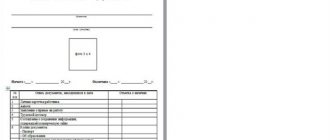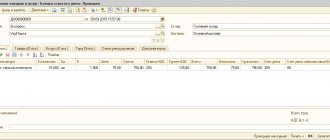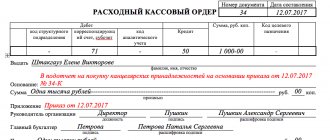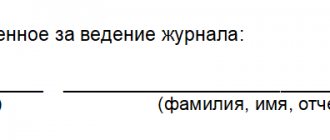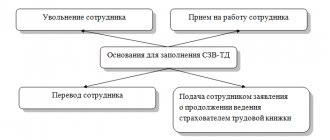Personal files are mandatorily maintained only for civil servants (Federal Law No. 79-FZ dated July 27, 2004, Decree of the President of the Russian Federation No. 609 dated May 30, 2005), while other organizations or individual entrepreneurs can conduct them at will. But despite this, personal affairs are conducted almost everywhere. This is due to the fact that having a personal file simplifies access to the necessary information about employees and helps to systematize all data about their work activities.
Let us recall that a file is a document or a set of documents related to one issue or area of activity, placed in a separate cover (subclause 95, clause 3.2.2 of GOST R 7.0.8-2013, approved by order of the Federal Agency for Technical Regulation and Metrology dated October 17, 2013 No. 1185-st).
Since the procedure for maintaining personal files of employees for organizations and entrepreneurs is not regulated in any way, it would be advisable to develop and approve a regulation on the procedure for creating and maintaining personal files. It can reflect the composition of personal files, the procedure for its formation and maintenance, the circle of employees for whom the files need to be maintained, the storage mode and the procedure for accessing files, etc.
Composition of an employee's personal file
Both original documents and copies are placed in the personal file. In this case, all copies must be properly certified. Documents that have a permanent or temporary (over 10 years) storage period should be placed in your personal file. The storage periods for documents are established by order of the Ministry of Culture of Russia dated August 25, 2010 No. 558. However, in practice, almost all documents related to the employee are stored in the files, as this is convenient.
Documents included in a personal file can be divided into three groups. Firstly, documents provided by employees and documents recording employment. These include:
- questionnaire;
- summary;
- recommendations and characteristics from previous places of work (if available);
- copies of passport, SNILS, INN (if available), education documents, military registration documents (for those liable for military service and persons subject to conscription);
- a certificate of the presence (absence) of a criminal record or the fact of criminal prosecution or the termination of criminal prosecution on rehabilitative grounds (when applying for a job related to an activity to which persons who have or have had a criminal record, are or have been subject to criminal prosecution are not allowed);
- application for a job;
- medical certificates (for employment of minors and other persons in cases provided for by the Labor Code of the Russian Federation);
- employment contract;
- personal card in form T-2 (approved by Resolution of the State Statistics Committee of the Russian Federation dated January 5, 2004 No. 1);
- copy of the employment order, etc.
Secondly, documents arising during the labor activity of employees. This list may include:
- copies of marriage (divorce) certificates, children’s birth certificates, driver’s licenses;
- agreement (its copy) on financial liability (for financially responsible persons);
- job descriptions;
- additional agreements to the employment contract;
- copies of orders on transfer, promotion, application and removal of disciplinary sanctions, promotion, etc.;
- certificates of results of periodic medical examinations (examinations);
- copies of documents establishing disability and limited ability to work (for employees with these indications);
- non-disclosure agreement (if the employee has access to confidential information);
- certification sheets;
- reports, explanatory notes, memos, applications for granting leave to the employee;
- various acts and notifications;
- copies of documents on advanced training, etc.
Thirdly, documents on termination of employment, for example:
- employee's resignation letter;
- a copy of the dismissal order.
It is worth noting that you can place a copy of the work book in your personal file, but not the book itself. Let us remind you that labor documents and their inserts are stored as strictly accountable documents, that is, in metal cabinets, safes or specially equipped premises under conditions that preclude their damage and theft, and are issued to the person responsible for maintaining them only upon his application.
How to stitch personal cards of dismissed workers into the archive
A personal card is also important because experienced personnel officers are well aware that it is connected with maintaining military records. And this largely determines the need to create personal cards in the form of a card index. The maintenance of such a file is established by the Instruction of the General Staff of the Armed Forces of the Russian Federation on maintaining military records in organizations, which is not officially published and therefore has a rather advisory nature, as well as the Regulations on military records, approved by Decree of the Government of the Russian Federation of November 27, 2021 N 719 (as amended Decree of the Government of the Russian Federation dated April 16, 2021 N 277) (Fig.
We recommend reading: Tax deduction for additional educational services
1). Example. Section III of the Regulations on Military Registration (extract): 30. The forum administration is not responsible for messages posted by forum participants. At the same time, we kindly ask participants not to violate the current legislation when communicating: when quoting someone’s works, do not violate the rights of authors, do not disseminate false information that defames anyone, do not disclose anyone’s personal data, etc.
Formation and maintenance of a personal file
Personal files can be kept for all employees or only for certain ones (for example, for management staff, accounting employees, financially responsible persons, etc.). In most cases, the registration of personal files is carried out by an employee of the personnel department, appointed responsible for their maintenance and storage. The responsibilities of this employee usually include creating a personal file, making various entries into it, placing and removing documents, certifying copies, maintaining an internal inventory, periodically checking the state of affairs, etc.
The formation of a personal file begins at the moment an employee is hired and continues throughout his entire career in this organization. Each personal file should be stored in a separate folder, on the title page of which the following should be indicated:
- name of company;
- the structural unit in which the employee works;
- personal file number;
- title, that is, the employee’s full name;
- date of commencement of personal file management (usually the date of issuance of the employment order);
- the date of completion of its maintenance (date of issuance of the dismissal order);
- the number of sheets of the file itself (it is best to fill out this column when submitting your personal file to the archive);
- retention period (registered when closing a personal file).
The title page form is given in Appendix 11 to the Basic Rules for the Operation of Archives of Organizations (hereinafter referred to as the Rules), approved by the decision of the Board of Rosarkhiv dated 02/06/2002.
After filling out the title page, all necessary documents are placed in a folder in chronological order. However, very often questions arise about the order of arrangement of documents presented by the employee and papers recording the fact of employment. This is due to the fact that they almost always have the same date. In most cases, these papers are arranged as follows:
- personal card in form T-2;
- questionnaire;
- summary;
- application for a job;
- a copy of the employment order;
- employment contract;
- copies of passport, SNILS, TIN (if available), military registration documents (for those liable for military service and persons subject to conscription for military service), etc.
Simultaneously with the personal file, they begin to keep an internal inventory of it, which is drawn up on a separate sheet and attached to the file. An inventory is compiled to record documents of permanent and temporary (over 10 years) storage. The internal inventory is filled out throughout the entire period of maintaining a personal file. It records the receipt of new documents or the removal of papers (for example, the storage period has expired), as well as the replacement of originals with copies. The internal inventory form is given in Appendix 10 to the Rules and must contain:
- number and title (full name of the employee) of the personal file to which it is compiled;
- column “document serial number”;
- column “document index” (filled in if available);
- column “document date”;
- column “document title”;
- the column “date of inclusion of the document in the personal file”;
- the “note” column, which usually reflects changes in the composition of the case documents (withdrawals, replacement with copies, etc.).
All personal matters are recorded in a logbook. The shape of the magazine is not approved, and you can make it yourself. Most often, personal file numbers, dates of their establishment, headings, and closing dates are entered in the columns.
Undated documents should be generated after dated ones
But only on the condition that these documents really should be stored in this personal file, which is established by the relevant regulatory documents - Model or departmental lists, Decree No. 640, etc. If you can establish that documents included in the second group should not be stored in a personal file, it is necessary to seize such documents and carry out further work with them in accordance with established requirements (form them into separate files or with other files, transfer them according to the delivery list to the archive, or set aside for destruction according to the act, etc.).
Question 2: In the employee’s personal file, the employment order is dated earlier than his application. In what order should the specified documents be formed in the personal file?
Answer: Personal records are usually arranged in chronological order. However, according to the logic of the events reflected in these documents, the employee first had to write an application for employment, and only then an order should have been issued. In this case, to systematize documents, a logical sequence should be observed. Based on the meaning of the Basic Rules for the Formation of Cases, such non-standard situations should be reflected in the appropriate preface to the inventory.
The prefaces could look like this:
Example 1. Individual documents of personal files that do not have dates, but were previously included in the inventory of documents available in the personal file, are formed at the end of each file before the inventory, not recorded - after the inventory. In a number of personal files, employee bypass sheets that were previously included in the inventory of documents available in the personal file were left.
Example 2. In the employee’s personal file, the employment order is dated earlier than the application. This order was not preserved in the process of systematizing the documents of this personal file. The documents are presented in a logical sequence, that is, in the order that must be followed when applying for a job.
From the situations considered, it is clear how difficult the process of preparing personal files for archival storage is due to their non-compliance with current regulatory documents.
Personal file storage
All personal files contain the employee’s personal data. Let us remind you that personal data means any information relating to a directly or indirectly identified or identified individual (Article 3 of the Federal Law of July 27, 2006 No. 152-FZ). The employer is obliged to comply with all requirements for the protection of personal data provided for by Chapter 14 of the Labor Code of the Russian Federation and Federal Law No. 152-FZ of July 27, 2006.
note
Persons guilty of violating the provisions of the legislation in the field of personal data may be brought to disciplinary (subclause 6 of Article 81 and Article 192 of the Labor Code of the Russian Federation) and material (clause 7, part 1 of Article 243 of the Labor Code of the Russian Federation) liability , as well as civil, administrative (Articles 13.11 and 13.14 of the Code of Administrative Offenses of the Russian Federation) and criminal (Articles 137 and 140 of the Criminal Code of the Russian Federation).
Thus, the head of the organization is obliged to appoint, by appropriate order, persons responsible for maintaining and storing personal files. At the same time, persons who have access to personal data are obliged not to disclose to third parties or distribute this data without the consent of the subject of personal data, unless otherwise provided by federal law.
Personal files must be stored in a place that excludes access to them by third parties, as well as the possibility of their theft or loss. For example, in safes or metal cabinets. Personal files in the storage location can be systematized in alphabetical order, by number or by structural divisions of the organization.
Please note that persons guilty of violating the provisions of the legislation in the field of personal data may be subject to disciplinary action (subclause 6 of Article 81 and Article 192 of the Labor Code of the Russian Federation) and material penalties (clause 7 of Part 1 of Article 243 Labor Code of the Russian Federation) liability, as well as civil, administrative (Articles 13.11 and 13.14 of the Code of Administrative Offenses of the Russian Federation) and criminal (Articles 137 and 140 of the Criminal Code of the Russian Federation).
Also, in order to ensure the protection of personal data stored by the employer, employees have the right to:
- to full information about their personal data and the processing of this data;
- free access to their personal data, including the right to receive copies of any record containing their personal data, except for the cases provided for in paragraph 8 of Art. 14 Federal Law of July 27, 2006 No. 152-FZ;
- identifying your representatives to protect your personal data;
- access to medical records reflecting their health status through a health professional of their choice;
- requirement to exclude or correct incorrect (incomplete) personal data, as well as data processed in violation of legal requirements. If the employer refuses to exclude or correct the employee’s personal data, he has the right to declare in writing to the employer his disagreement with the appropriate justification for such disagreement. The employee has the right to supplement personal data of an evaluative nature with a statement expressing his own point of view;
- the requirement that the employer notify all persons who were previously informed of incorrect (incomplete) personal data of the employee about all exceptions, corrections or additions made to them;
- appealing to the court any unlawful actions or inaction of the employer in the processing and protection of his personal data.
Personal data can be transferred to third parties only with the written consent of the employee. The exception is the transfer of this data to third parties in order to prevent a threat to the life and health of an employee, as well as in other cases provided for by federal laws.
How to create an archive of personal files of dismissed employees
Keep the personal files of employees for 75 years, keep the personal files of managers, members of the governing, executive, control bodies of the organization, employees with state and other titles and awards - permanently (Article 656 of the list approved by order of the Ministry of Culture of Russia dated August 25, 2021 No. 558 ). Audit of personal files
At the same time, labor legislation does not regulate the composition of a personal file; the legislation does not provide for any requirements for filling out a personal file. Moreover, maintaining an employee’s personal file is not mandatory. Keep personal files of current employees only in the HR department. Transfer the files of resigned employees to the archives for storage. The procedure for creating a personal file is indicated below in the text. In accordance with paragraph 3.6.4 of the Rules, approved by the decision of the board of Rosarkhiv dated February 6, 2021, file the documents of your personal file with four holes in a hard cardboard cover (binder) or bind them in such a way that you can read the text of all documents, including including date, visa and resolution. Before filing (binding), remove staples from all documents. At the beginning of the case, attach the forms for the internal inventory of the documents of the case, and at the end - the forms of the sheets certifying the case. Keep the personal files of employees for 75 years, and keep the personal files of managers, members of the governing, executive, and control bodies of the organization, employees with state and other titles and awards, forever.
We recommend reading: Photo for a medical book
How to stitch personal employee cards
If each personal file of a dismissed employee is filed separately, the personal file includes an internal inventory of the case documents, which is compiled in the process of maintaining the personal file, and a certification sheet. In the title, indicate the surname, first name, and patronymic of the dismissed employee in the nominative case. The closing dates of the personal file are the dates of orders for the acceptance and dismissal of the employee.
Personal card code according to OKUD 0301002. To a personal card in accordance with Art. 65 of the Labor Code of the Russian Federation, data is entered on the basis of documents that the employee must bring with him when applying for a job: - passport; - work book (or a copy thereof for part-time workers); - SNILS (insurance certificate); - TIN (certificate of registration at the tax office); - military ID (for those liable for military service); - educational document (diploma, certificate, courses, etc.), confirming the presence of knowledge specific to the job. In addition to this data, the personal card contains information that is filled out based on information provided by the employee himself. Personal card T-2 form download here. Filling out a personal card (instructions) here. How to calculate vacation pay correctly and have time to relax.
